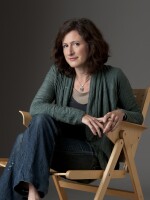SCOTT SIMON, HOST:
A word of caution now. You're about to hear the old nursery rhyme "Little Jack Horner" in the creepy voice of one of the world's first talking dolls.
(SOUNDBITE OF TALKING DOLL)
UNIDENTIFIED WOMAN: (As doll) Little Jack Horner sat in a corner, eating a...
SIMON: Thomas Edison built and sold about 500 of these talking dolls back in 1890. NPR's Neda Ulaby says that new technology has made hearing the dolls possible for the first time in decades.
NEDA ULABY, BYLINE: And you may never unhear this glassy-eyed cherub shrieking out a child's prayer.
(SOUNDBITE OF TALKING DOLL)
UNIDENTIFIED WOMAN: (As doll) Now I lay me down to sleep. I pray the Lord my soul to keep.
ULABY: That's most likely one of Edison's female factory workers imitating a little girl, or so says Jerry Fabris. He curates sound recordings at Thomas Edison National Historical Park. Fabris says Edison was, for the first time, trying to market the then brand-new, wax-cylinder phonograph for people to use at home. He thought the best vehicle would be a doll.
JERRY FABRIS: About two feet tall - it would have wooden arms and legs.
ULABY: Encased in its metal body was a miniature phonograph, spring-activated by a crank sticking out of the doll's back. Edison knew the sound quality was raw, so he had the dolls recite recognizable verses, like "Hickory Dickory Dock."
(SOUNDBITE OF TALKING DOLL)
UNIDENTIFIED WOMAN: (As doll) Hickory, dickory, dock. The mouse ran up the clock.
ULABY: Were these pleasant to listen to back in 1890?
FABRIS: No, I don't think so. Edison himself thought they were unpleasant.
ULABY: So did everyone else. The dolls flopped in the market, not because people thought they were creepy but because they were expensive, about $200 in today's money. And people thought the dolls were not lifelike enough. They wanted moving mouths and the dolls' voices to be understandable. Edison stopped making the talking dolls after about a month.
FABRIS: After the business failed, he referred to them as little monsters.
ULABY: Which raises a larger question. Why do we find talking dolls so scary?
(SOUNDBITE OF FILM, "CHILD'S PLAY")
BRAD DOURIF: (As Chucky) Hi, I'm Chucky. Want to play?
CATHERINE HICKS: (As Karen Barclay, screaming).
ULABY: Talking toys occupy their own horror sub-genre that led to their own parodies.
(SOUNDBITE OF TV SHOW, "TWILIGHT ZONE")
JUNE FORAY: (As Talking Tina Doll) My name is Talking Tina, and I love you very much.
TELL SAVALAS: (As Erich Streator) Will you shut that thing off?
FORAY: (As Talking Tina Doll) My name is Talking Tina, and I think I could even hate you.
(SOUNDBITE OF TV SHOW, "THE SIMPSONS")
DANIEL CASTELLANETA: (As Krusty the Clown Doll) I'm Krusty the Clown, and I don't like you.
(As Homer Simpson, laughing).
(As Krusty the Clown Doll) I'm Krusty the Clown, and I'm going to kill you.
(As Homer Simpson, laughing) Didn't even pull the string that time.
ULABY: A talking toy belongs in an unsettling middle space, says horror scholar Caetlin Benson-Allott. It's human, but not that human.
CAETLIN BENSON-ALLOTT: Where it's both familiar and different, and we don't kind of understand if it's entirely dead or entirely alive.
ULABY: It's what Sigmund Freud called the uncanny, she says. And we can feel it as a subconscious holdover from childhood when we pretend our dolls are real. Even as knowing grown-ups, it's that lurking apprehension, she says.
BENSON-ALLOTT: That that doll is actually alive and watching me.
ULABY: Benson-Allott says we've probably freaked ourselves out with dolls for as long as we've used dolls in rituals and in play. When we give anything power, she says, from a talking doll to technology, there's a sense - even a fear - that that power might turn back on us.
(SOUNDBITE OF DOLL TALKING)
UNIDENTIFIED WOMAN: (As doll) Twinkle, twinkle little star, how I wonder what you are.
ULABY: Neda Ulaby, NPR News. Transcript provided by NPR, Copyright NPR.
NPR transcripts are created on a rush deadline by an NPR contractor. This text may not be in its final form and may be updated or revised in the future. Accuracy and availability may vary. The authoritative record of NPR’s programming is the audio record.


